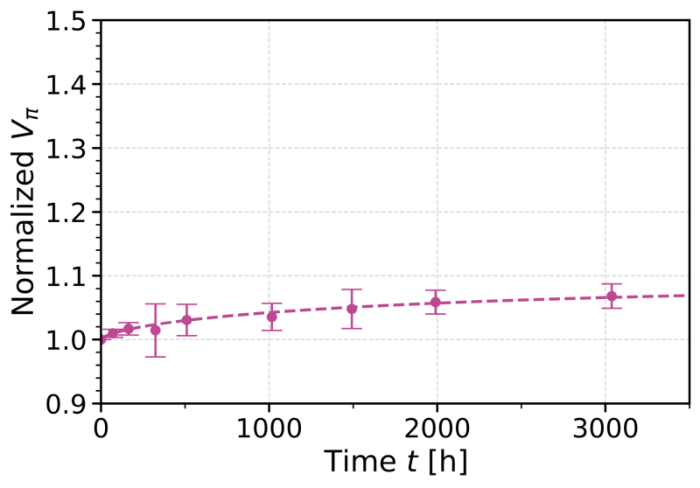Plasmonic Reliability
Reliability is at the heart for the commercialization of all Polariton’s electro-optic components and primarily concerns the materials and processes in the devices. The current generation of plasmonic devices employ organic materials that need protection from the environment, being oxygen and humidity. As for comparable technology such as organics in OLED displays, Polariton implements a proper encapsulation during manufacturing.
The Limit to Plasmonic Reliability is Realistic
As next generation of modulators is a race for materials, no matter whether a III/V or a Lithium derivate is preferred, also the organics used in plasmonics follow its well understood practical limit. This is related to the glass transition temperature Tg of the material, which has been rapidly evolving in the right direction in the past few years. Published knowledge indicates that one that the desired regime relates to a specific longevity. For instance, targeting 10 years corresponds to a ratio of 0.22 for the indicated formula in Kelvin.
Polariton employs exclusively advanced generations of organic materials, and while targeting 10 years of operation and shelf life, defines the practical operation regime between 110 and 120°C, assuming the protection from oxygen and humidity.

Practical limit to polymer longevity, with a ratio below 0.22 for 10 years of operation. Adapted from M. Bösch, ETH Diss. No. 14192, Electro-Optic Polymers, Photochemical Stability and In-Line Modulator
High-Temperature Storage (HTS)
Long-term storage at 85°C provides an excellent way to demonstrate the ever-improving encapsulation technology. Among the different electrical and optical properties that are evaluated, the key metric for aging is the half-wave voltage Vπ, therefore only this one is discussed here.
Find here the newest results of a normalized Vπ for plasmonic MZMs stored at high temperature and measured periodically. A single-term exponential was fit to the averaged data points. The exponential convergence is in line with theoretical considerations.

HTS, 85°C, change of Vπ less than 10% in 3000 hours. Narrow confidence intervals
Damp Heat Test
Damp heat tests determine suitability of products for high humidity conditions, non-condensing, with or without temperature changes, and are often associated with other tests. Also, for damp heat testing, the key metric for aging is the half-wave voltage Vπ, therefore only this one is discussed here.
Find here the newest results of a normalized Vπ for plasmonic MZMs stored at high temperature and measured periodically. A single-term exponential was fit to the averaged data points. The exponential convergence is in line with theoretical considerations.

Damp heat, change of Vπ less than 5% in 500 hours. The confidence interval is at the moment larger than without humidity
High-Temperature Operating Life (HTOL)
Tests performed at 85°C and 105°C, biased and stressed with various optical input power. Coming soon.